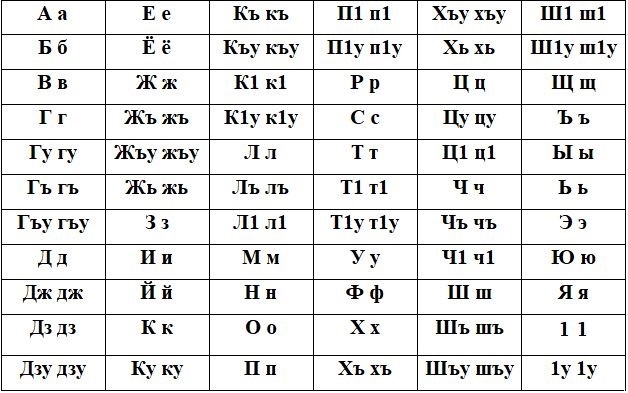Тхыпкъылъэм фэгъэхьыгъэу (On the alphabet)
There are 66 letters in the Circassian alphabet (Western dialect): 3 simple vowels (а, э, ы), 7 diphthongs (е, и, о, у, ё, ю, я), 56 consonants (б, в, г, гу, гъ, гъу, д, дж, дз, дзу, ж, жъ, жъу, жь, з, й, к, ку, къ, къу, к1, к1у, л, лъ, л1, м, н, п, п1, п1у, р, с, т, т1, т1у, ф, х, хъ, хъу, хь, ц, цу, ц1, ч, чъ, ч1, ш, шъ, шъу, ш1, ш1у, щ, ъ, ь, 1, 1у). Cyrillic is used to indicate the sounds (phonemes) in writing. Combined letters (digraphs and trigraphs) are formed by combining two or more letters. For example:  The Circassian language (Western dialect) has a three-layered series of consonant sounds, where two unvoiced consonants are needed for one voiced consonant (б, п, п1; д, т, т1; дз, ц, ц1; дж, ч, к1 и т. д.). Most consonants are hard (б, д, г, м, н, х, з, с, т, ф, и т. д.), but there are always soft phonemes (жь, л, ч, щ, лъ, дж). There paired non-labialized (non-labial) and labialized (labial) sounds: г-гу, гъ-гъу, къ-къу, хъ-хъу, жъ-жъу, ш1-ш1у, шъ-шъу, 1-1у. The labialized (for which the letter у is used) sounds can be indicated in two ways, so in modern Adyghe (Circassian) orthography there exist the following variants: гу-го, гъу-гъо, дзу-дзо, жъу-жъо, къу-къо, п1у-п1о, т1у-т1о, хъу-хъо, шъу-шъо, ш1у-ш1о, 1у-1о. The letter к1 represents two different sounds:
The Circassian language (Western dialect) has a three-layered series of consonant sounds, where two unvoiced consonants are needed for one voiced consonant (б, п, п1; д, т, т1; дз, ц, ц1; дж, ч, к1 и т. д.). Most consonants are hard (б, д, г, м, н, х, з, с, т, ф, и т. д.), but there are always soft phonemes (жь, л, ч, щ, лъ, дж). There paired non-labialized (non-labial) and labialized (labial) sounds: г-гу, гъ-гъу, къ-къу, хъ-хъу, жъ-жъу, ш1-ш1у, шъ-шъу, 1-1у. The labialized (for which the letter у is used) sounds can be indicated in two ways, so in modern Adyghe (Circassian) orthography there exist the following variants: гу-го, гъу-гъо, дзу-дзо, жъу-жъо, къу-къо, п1у-п1о, т1у-т1о, хъу-хъо, шъу-шъо, ш1у-ш1о, 1у-1о. The letter к1 represents two different sounds:
It bears mentioning that diphthongs consist of two sound:

Ъ (hard sign) and Ь (soft sign) do not form sounds. All the elements of the letters are called symbols / signs separately. The letters and sounds can consist of a single sign/symbol or as a combination of two or three signs/symbols.

